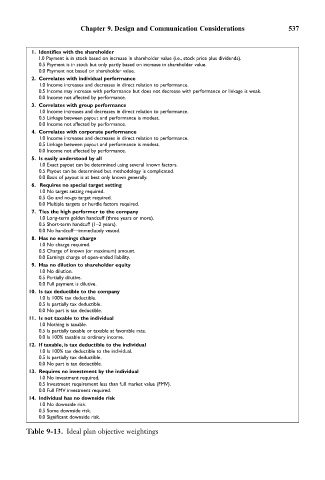Page 551 - Bruce Ellig - The Complete Guide to Executive Compensation (2007)
P. 551
Chapter 9. Design and Communication Considerations 537
1. Identifies with the shareholder
1.0 Payment is in stock based on increase in shareholder value (i.e., stock price plus dividends).
0.5 Payment is in stock but only partly based on increase in shareholder value.
0.0 Payment not based on shareholder value.
2. Correlates with individual performance
1.0 Income increases and decreases in direct relation to performance.
0.5 Income may increase with performance but does not decrease with performance or linkage is weak.
0.0 Income not affected by performance.
3. Correlates with group performance
1.0 Income increases and decreases in direct relation to performance.
0.5 Linkage between payout and performance is modest.
0.0 Income not affected by performance.
4. Correlates with corporate performance
1.0 Income increases and decreases in direct relation to performance.
0.5 Linkage between payout and performance is modest.
0.0 Income not affected by performance.
5. Is easily understood by all
1.0 Exact payout can be determined using several known factors.
0.5 Payout can be determined but methodology is complicated.
0.0 Basis of payout is at best only known generally.
6. Requires no special target setting
1.0 No target setting required.
0.5 Go and no-go target required.
0.0 Multiple targets or hurdle factors required.
7. Ties the high performer to the company
1.0 Long-term golden handcuff (three years or more).
0.5 Short-term handcuff (1–2 years).
0.0 No handcuff—immediately vested.
8. Has no earnings charge
1.0 No charge required.
0.5 Charge of known (or maximum) amount.
0.0 Earnings charge of open-ended liability.
9. Has no dilution to shareholder equity
1.0 No dilution.
0.5 Partially dilutive.
0.0 Full payment is dilutive.
10. Is tax deductible to the company
1.0 Is 100% tax deductible.
0.5 Is partially tax deductible.
0.0 No part is tax deductible.
11. Is not taxable to the individual
1.0 Nothing is taxable.
0.5 Is partially taxable or taxable at favorable rate.
0.0 Is 100% taxable as ordinary income.
12. If taxable, is tax deductible to the individual
1.0 Is 100% tax deductible to the individual.
0.5 Is partially tax deductible.
0.0 No part is tax deductible.
13. Requires no investment by the individual
1.0 No investment required.
0.5 Investment requirement less than full market value (FMV).
0.0 Full FMV investment required.
14. Individual has no downside risk
1.0 No downside risk.
0.5 Some downside risk.
0.0 Significant downside risk.
Table 9-13. Ideal plan objective weightings

